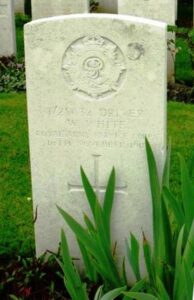The Parish Church at Llandyfriog is dedicated to St Tyfriog, and inside, as well as the parish war memorial, is a memorial to the 12th Divisional Train, Army Service Corps. At first glance there is no obvious link with any of the men on the memorial to the area, but after some research, I have found that the unit was commanded by Lieutenant-Colonel Edward Crawford Lloyd Fitzwilliams, CMG, of Brynteifi, Llandyfriog. Fitzwilliams must have thought a lot of his men, as he commissioned this memorial to the men of his unit who fell during the Great War. The memorial fails to commemorate one local man, William Lloyd Davies, who served with the unit, and died on 23 February 1920 as a result of being gassed during the war. William is not recognised as a casualty of war by the Commonwealth War Graves Commission, and isn’t commemorated on the plaque, but has been added below.
12th Divisional Train Memorial, Llandyfriog
Lieutenant-Colonel Edward Crawford Lloyd Fitzwilliams, CMG
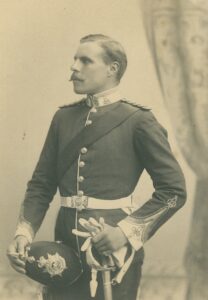
A Short History of the 12th Divisional Train, Army Service Corps, during the Great War
The 12th Divisional Train consisted of 116, 117, 118 and 119 Companies Army Service Corps (ASC), and was attached to the 12th (Eastern) Division, which had formed in August 1914 as part of Kitchener’s First New Army (K1). The Division concentrated in late August 1914, with 35 Brigade based around Shorncliffe, 36 Brigade at Colchester, 37 Brigade at Purfleet, the Engineers and RAMC at Hounslow, and the ASC at Aldershot, before moving to Lord’s Cricket Ground. The Division embarked for France between 29 May and 1 June 1915, landing at Boulogne and Havre, before concentrating near St Omer.
The Division moved to the Meteren-Steenwerck area for trench initiation, alongside the 48th (South Midland) Division, taking over a section of the front line at Ploegsteert Wood on 23 June 1915.
The Division fought at The Battle of Loos from 30 September 1915, fighting around the Hulloch Quarries and at the Hohenzollern Redoubt, suffering heavy casualties. The Division remained in the Loos sector over the coming months, until moving to Flesseles in June 1916, preparatory to taking up positions on the Somme in reserve.
The Battle of the Somme opened on 1 July 1916, and the Division moved through Albert to relieve the 8th Division at Ovillers-la-Boisselle that night, prior to attacking the following morning. They successfully captured their objectives during heavy fighting over the coming days, before being relieved, moving to Contay. After a brief period of rest, the Division took part in the Battle of Pozieres on 3 August 1916, before being evacuated to Arras.
The Division was still at Arras when the Battle of Arras was launched, and fought at The First Battle of the Scarpe, The Battle of Arleux and The Third Battle of the Scarpe. They remained in the Arras sector until the 30 October 1917 when they moved to the Cambrai sector, and took part in the Battle of Cambrai.
After the Germans had launched their offensive on the Somme on 21 March 1918, the 12th Division was moved to Albert, and was thrown into a desperate defensive action on the old Somme battlefields of 1916. The Division remained in this area until July 1918, when it moved further south, and took part in the great offensive which was launched on the Somme on 22 August 1918.
The Division made great progress during the offensive, capturing Meaulte, Mametz, Carnoy, Hardecourt and Faviere Wood within a week, whilst driving towards the Canal du Nord and the Hindenburg Line. It took part in the Battle of Epehy and The Battle of the St Quentin Canal, which saw the Hindenburg Line broken, and from October 1918 participated in The Final Advance in Artois, reaching the Scheldt Canal by 27 October 1918. After the armistice, the Division moved to the area east of Douai, where it remained until demobilisation, and by 22 March 1919 the Division had ceased to exist.
The Memorial
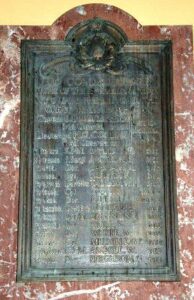
William Good Andree, Company Quartermaster Sergeant, T2/SR/03914, Army Service Corps. William was born at Bangalore, India, the son of John Henry Andree, and of Alicia Sarah Andree (nee Good). The family later resided at Ceylon, while William returned to Britain, residing at Hammer, Surrey. At the outbreak of war William enlisted at Northampton into the 12th Divisional Train, Army Service Corps. He landed in France on 29 May 1915 with the Division, and served in France until dying on 7 May 1916, aged 40. William is buried at Lapugnoy Military Cemetery, France, in grave I. F. 41.
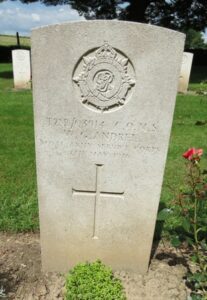
Albert Edward Barham, Driver, T1/4716, Army Service Corps. Albert was the son of Walter and Emily Barham, of Wickham Market, Suffolk. He was posted to France at some time after 1916, joining the 12th Divisional Train, Army Service Corps. Albert became ill in France, and was invalided home, dying on 18 February 1918, aged 24. He is buried at Dallinghoo (St. Mary) Churchyard, England. His brother, George Edward Barham, also fell.
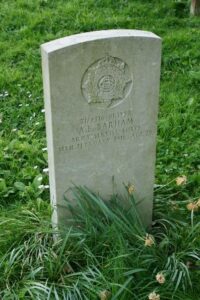
James Brennan, Shoeing Smith, TS/5925, Army Service Corps. James was the son of James and Elizabeth Brennan, of Aughaterry, Ballickmoyler, Co. Carlow. He enlisted at Carlow into the Army Service Corps, and landed in France with the 12th Divisional Train, Army Service Corps on 30 May 1915. James served in France with the Division throughout the war, but died of influenza at 23 Casualty Clearing Station on 10 November 1918, aged 26. He is buried at Brebieres British Cemetery, France, in grave D. 1.
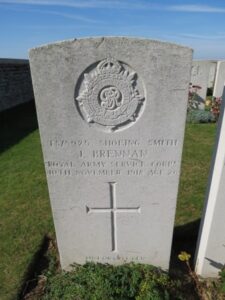
Edward Budd, MC and Two Bars, Captain, Irish Guards. Edward was the son of Sir Cecil L. Budd, K.B.E., and of Bloom Budd, of The Briars, Reigate, Surrey. He was educated at Winchester prior to receiving a commission into the Army Service Corps, and landed in France on 30 May 1915, attached to the 12th Divisional Train, Army Service Corps. Edward was later promoted Captain, and transferred into the 1st Battalion, Irish Guards. He was obviously a brave man, as during his time at war, Edward was awarded the Military Cross three times- a rare feat. He was killed in action during the latter stages of the German offensive, on 8 May 1918, aged 24. Edward is buried at Ayette British Cemetery, France, in grave B. 3. The London Gazette dates and citations for Edward’s awards of the Military Cross are as follows;
11 May 1917. M.C. to Lieutenant Edward Budd. Irish Guards, Special Reserve (attached 1st Battalion): “For conspicuous gallantry and devotion to duty. He carried out a dangerous reconnaissance under very heavy fire, and brought back most valuable information. He has on many occasions done fine work.”
8 January 1918. Bar to M.C. to Lieutenant Edward Budd, M.C., Irish Guards, Special Reserve: “For conspicuous gallantry and devotion to duty. After a personal reconnaissance of an enemy blockhouse which was harassing his front line, he made sound and skilful disposition for its capture which was effectively carried out. The capture of the blockhouse not only relieved the front line from annoyance and loss, but enabled the whole line in this vicinity to be advanced about 200 yards. He showed very great initiative and military skill.” (M.C. gazetted 11 May 1917).
5 July 1918. Second Bar to M.C. to Lieutenant (Acting Captain) Edward Budd, M.C., Irish Guards, Special Reserve: “For conspicuous gallantry and devotion to duty. He led his company with great skill and judgment, and during the subsequent consolidation displayed marked ability and disregard of danger, reorganising his own company and rendering great assistance to neighbouring company commanders. Later, when, during an enemy attack, all communications were cut, he volunteered to go up to the front line and clear up the situation. He successfully accomplished this task, in spite of continuous sniping and machine-gun fire. Throughout the operations his coolness was most marked, and his sound judgment was of the greatest help to his battalion commander.”
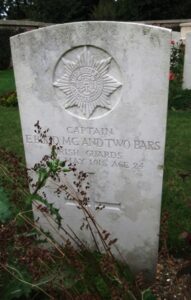
William Cole, Driver, T4/038159, Army Service Corps. William was the son of Henry and Sarah Cole, of Boughton Monchelsea, Kent, and the Husband of Ellen Cole (nee Lawrence). He enlisted on 29 December 1914 into the Army Service Corps, and landed in France on 25 September 1915, joining the 12th Divisional Train, Army Service Corps. William served with the Division for the duration of the war, but became a casualty of the influenza epidemic, dying at 23 Casualty Clearing Station on 11 November 1918, aged 24. William is buried at Brebieres British Cemetery, France, in grave D. 8.
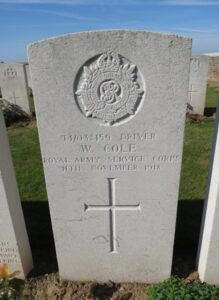
Harold George Collins, Lieutenant, Royal Flying Corps. Harold was the son of Daniel George Collins, and of Mary F Collins, of Shirley Park, Croydon, Surrey. He was educated at Wellingborough College, and enlisted into the Buffs at the outbreak of war. Harold was commissioned into the Army Service Corps in January 1915, and was posted to France that month. From May 1915 he became attached to the 12th Divisional Train, Army Service Corps, serving with the Division until volunteering to serve with the Royal Flying Corps early in 1916, joining 48 Squadron, RFC, which was equipped with the Bristol fighter. On 9 April 1917, the month which was to become infamously known as ‘Bloody April’, Harold was flying as an Observer aboard Bristol F2A, Serial A3315. The aircraft was on patrol with another Bristol when it came into contact with five aeroplanes from Manfred Von Richtofen’s Flying Circus, near Arras. During the hectic fight which followed, two German Albatross DIII’s were shot down, but Harold’s machine had been cut to ribbons, and Harold lay dying in the back, after bravely continuing to fire his machine gun even with one hand almost severed by machine-gun fire. His Pilot, Lieutenant J H T Letts, was unhurt, and with difficulty managed to get the stricken aircraft back to base, where Harold’s body was pulled from his seat. Harold was 22 years old, and is buried at Warlincourt Halte British Cemetery, Saulty, France, in grave VI. J. 14.
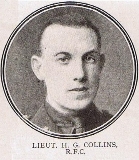
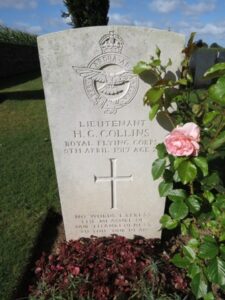
William Lloyd Davies, Wheeler, T4/060246, Royal Army Service Corps. William was born in 1888, the son of John and Rachel Davies, of 2, Mill Street, Newcastle Emlyn. He served with the 12th Divisional Ammunition Column, Army Service Corps during the war, after landing with his unit at Boulogne on 30 May 1915. William survived the war, but had been gassed during the latter stages of the war. On 17 April 1919 he was demobilised, and returned to Newcastle Emlyn, where he died on 23 February 1920, aged 32, as a result of his gassing. William is not commemorated by the CWGC.
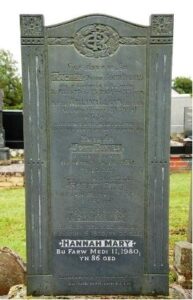
Gilbert Ferguson, Driver, T2/10908, Army Service Corps. Gilbert was the son of James and Janet Ferguson, of Scotland. Gilbert was originally attached to the Motor Transport Company Headquarters, before being attached to 35 Infantry Brigade, 12th Divisional Train, Army Service Corps. He survived the war, but was to become another casualty of the influenza epidemic, dying on 25 November 1918, aged 25. Gilbert is buried at Valenciennes (St. Roch) Communal Cemetery, France, in grave I. E. 22.
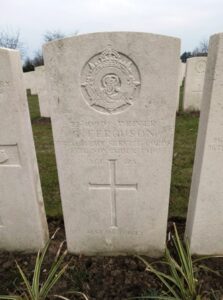
Joseph Eli Giles, Driver, T2/9864, Army Service Corps. Joseph was the son of George and Jane Giles, of 85, Stafford Road, Grangetown, Cardiff. He had enlisted into the Army Service Corps at the outbreak of war, and was posted to the 12th Divisional Train, Army Service Corps, landing in France with the Division on 1 June 1915. Joseph served in France with the Division until being killed in action during the build up to the great offensive which was to ultimately win the war for the allies, on 17 August 1918, aged 20. He was buried at Caix British Cemetery, France, in grave I. C. 11.
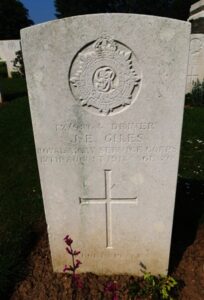
Frederick Howes, Sergeant, S1/4054, Army Service Corps. Frederick served with No 4 Company, 12th Divisional Train, Army Service Corps for most of its time at war. He was to become another casualty of the influenza epidemic, dying on 2 December 1918. Frederick is buried at Auberchicourt British Cemetery, France, in grave I. C. 13.
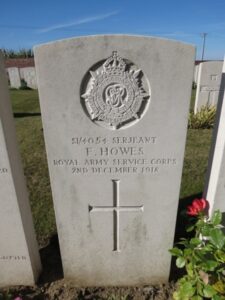
Arthur R Jackson, Sergeant, S4/060085, Army Service Corps. Arthur landed in France on 1 June 1915 with the 12th Divisional Train, Army Service Corps. He served in France until around the time of the Battle of Arras in April 1917, when he was invalided home. Arthur died on 22 August 1917, aged 38, and is buried at Oxford (Rose Hill) Cemetery, England, in grave C4. 243.
Harry E. Jones, Driver, T3/025600, Army Service Corps. Harry landed in France on 30 May 1915, attached to the 12th Divisional Train, Army Service Corps. He served right through the war, but became another casualty of the influenza epidemic, dying at 23 Casualty Clearing Station on 10 November 1918. Harry is buried at Brebieres British Cemetery, France, in grave D. 2.
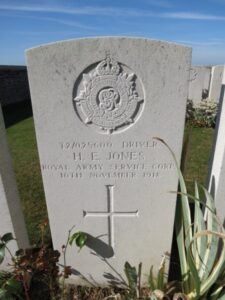
Charles Potter Melville, Corporal, T4/064325, Army Service Corps. Charles was the son of Theophilus and Annie Melville, of 118, Albert Street, Dundee. He landed in France on 30 May 1915 attached to the 12th Divisional Train, Army Service Corps. Charles served with the Division until being killed in action during the build up to the Cambrai offensive, on 11 October 1917, aged 25. He is buried at Faubourg D’Amiens Cemetery, Arras, France, in grave VI. A. 7.
Alfred Edward Myles, Staff Serjeant Major, T1SR/875, Army Service Corps. Alfred was the Husband of Elizabeth Myles, of 48, Mottram Road, Shawhall Newton, Hyde, Cheshire. He was an old soldier, having served with the Royal Dragoons, and Remounts prior to completing his 12 years service in 1897. Alfred rejoined the army in 1899, and signed up for another nine years, in order to complete 21 years service, but was discharged on 24 July 1910 at his own request, joining the army reserve. At the outbreak of the Great War, Alfred rejoined the army, and was rapidly promoted, before being posted to the 12th Divisional Train, Army Service Corps, landing in France with the Division on 31 May 1915. Alfred served with the Division in France until being invalided home on 24 December 1916, and was discharged from the army on 4 June 1917. Alfred died at the London General Hospital at Brixham, Surrey on 26 June 1917. He was 43 years old, and is buried at Nunhead (All Saints) Cemetery, where he is commemorated on the Screen Wall. 89. 32848.
James Ryan, Sergeant, 113031, Royal Flying Corps. James was the Husband of Jennie Ryan, of 33, Glamorgan St., Canton, Cardiff. He originally landed in France with the 12th Divisional Train, Army Service Corps on 1 June 1915, but at some time later, volunteered to serve with the Royal Flying Corps. James was posted to 55 Squadron, Royal Flying Corps, and was probably acting as an aerial observer when he was killed on 24 March 1918, aged 29. James is buried at Charmes Military Cemetery, Essegny, France, in grave I. G. 15. In the London Gazette of 12 September 1918, James was gazetted as being awarded the Italian Bronze Medal for Military Valour.
William Henry Taylor, Driver, T4/064422, Army Service Corps. William was the son of Mr. and Mrs. John Taylor, of Dover. He enlisted on 15 February 1915 into the Army Service Corps, and landed in France with the 12th Divisional Train, Army Service Corps on 1 June 1915. William served in France with the Division for the duration of the war, but became another victim of the influenza epidemic, dying at 42 Casualty Clearing Station on 25 March 1919, aged 25. William is buried at Douai British Cemetery, Cuincy, France, in grave E. 20.
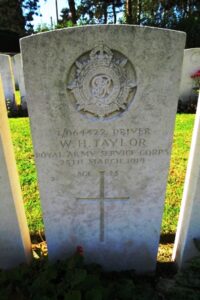
Walter White, Driver, T/25632, Army Service Corps. Walter was born at Plymouth, and was the husband of Lucy White, of 12, Prince Regent Street, Southsea, Portsmouth. He served with the 12th Divisional Train, Army Service Corps throughout the war, until becoming yet another casualty of the influenza epidemic, dying at the 20th General Hospital Étaples on 16 November 1918, aged 28. Walter is buried at Etaples Military Cemetery, France, in grave L. D. 7.
